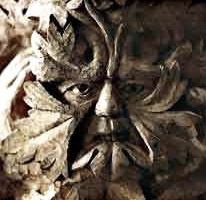
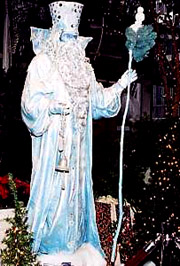 Santa Claus can be traced to a variety of older spirits (Holly King, Old Man Winter, Grandfather Frost -- to name a few) and ancient spirits (Dionysus, the Green Man, etc.). Like the goat-skin-clad Joulupukki of Finland, the powers of nature demanded appeasement during the Cold season. The agricultural discomfort with Cosmotic Nature led to the abundance of evil spirits during the Winter Solstice. Carols, burning of materials, and good behavior were tools to ward off the destructive forces that crept into the villages from the outlying wilderness.
Santa Claus can be traced to a variety of older spirits (Holly King, Old Man Winter, Grandfather Frost -- to name a few) and ancient spirits (Dionysus, the Green Man, etc.). Like the goat-skin-clad Joulupukki of Finland, the powers of nature demanded appeasement during the Cold season. The agricultural discomfort with Cosmotic Nature led to the abundance of evil spirits during the Winter Solstice. Carols, burning of materials, and good behavior were tools to ward off the destructive forces that crept into the villages from the outlying wilderness. Christianity entailed a splitting of the personality attributed to the Cosmos. God symbolized civilization's duties in social maintenance and the preservation of reorganized nature. Satan symbolized our basic Cosmotic yearnings. Accordingly, attention and appreciation of Cosmotic Nature and the quest for Reintegration (at the expense of agricultural obligations) would fall into the satanic camp.The new faith, however, was not capable of accounting for the day-to-day forces that endangered or irritated social life. For the Christians, a Zoroastrian power split was unacceptable, but the notions of Satan as a fallen angel and the King of Hell were too remote to account for domestic problems (such as marital strife or the corrosion of tools). Thus the local spirits could survive, but still gave the Church an allergic reaction. Its solution was to displace the enduring spirits with agreeable forms, and gradually soften their power.
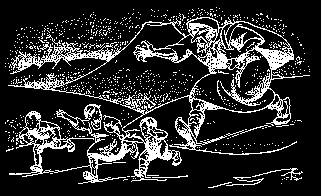 For example, Greek traditions held that the Kallikantzaroi were ugly monsters who emerged from their subterranean homes to wander the earth during the twelve days of Christmas. They were eventually domesticated into mischievious creatures who urinated on hearths, soured milk, and committed other acts of minor irritation. Similarly, the Icelandic Gryla and Leppayi were espoused trolls who seized and ate children who misbehaved. Emphasis eventually shifted to the Yulemen, their thirteen elf sons who conducted acts impish behavior such as stealing food and slamming doors.
For example, Greek traditions held that the Kallikantzaroi were ugly monsters who emerged from their subterranean homes to wander the earth during the twelve days of Christmas. They were eventually domesticated into mischievious creatures who urinated on hearths, soured milk, and committed other acts of minor irritation. Similarly, the Icelandic Gryla and Leppayi were espoused trolls who seized and ate children who misbehaved. Emphasis eventually shifted to the Yulemen, their thirteen elf sons who conducted acts impish behavior such as stealing food and slamming doors. The God of Nature -- the Wild Man of the Woods -- required a powerful remedy. To eclipse such satanic forces, the displacing supernatural being would have to be compatible with Christian cosmology. The selection was Bishop Nicholas, born in Asia Minor in the second century. When cannonized, he became the patron saint of seamen and children. In the fourteenth century there are the first references to St. Nicholas being the bearer of gifts (gold for dowries, to save maidens from prostitution). In the fourteenth century, St. Nicholas was employed to drain the power of Teutonic mythology by acquiring Odinistic quailities: a flowing white beard, the power to ride a beast-of-burden in the skies, and a penchant for descending to Earth in December with a sack of gifts for the needy.
The God of Nature -- the Wild Man of the Woods -- required a powerful remedy. To eclipse such satanic forces, the displacing supernatural being would have to be compatible with Christian cosmology. The selection was Bishop Nicholas, born in Asia Minor in the second century. When cannonized, he became the patron saint of seamen and children. In the fourteenth century there are the first references to St. Nicholas being the bearer of gifts (gold for dowries, to save maidens from prostitution). In the fourteenth century, St. Nicholas was employed to drain the power of Teutonic mythology by acquiring Odinistic quailities: a flowing white beard, the power to ride a beast-of-burden in the skies, and a penchant for descending to Earth in December with a sack of gifts for the needy.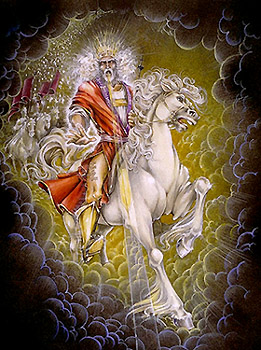
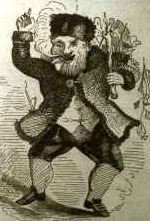 In many cases, St. Nicholas was accompanied by Black Peter: an enslaved Satan figure or elf employed to beat naughty children. The saint, en route to his transformation to today's jolly Santa Claus, still maintained his powers to punish and strike fear, but was a far cry from the profound threat that Cosmotic Nature posed to reorganized nature.
In many cases, St. Nicholas was accompanied by Black Peter: an enslaved Satan figure or elf employed to beat naughty children. The saint, en route to his transformation to today's jolly Santa Claus, still maintained his powers to punish and strike fear, but was a far cry from the profound threat that Cosmotic Nature posed to reorganized nature.Santa Claus today is a conflicted figure in the modern Christian world. For some, he is a functional boogeyman, and for others an irritating competitor to Christ. Although impotent and deflated since his days as the Wild Man of the Woods, he is acceptable as a supernatural figure that assists children in associating the Cold season and Cosmotic virtures of nature with joy and mystical excitement. Otherwise, Christ (as the Sun-God's rebirth) would be ill-equippted to supplant this enthusiasm for Wintry nature.
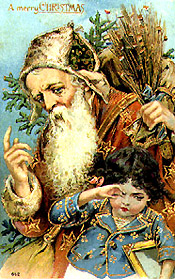
Presented by the Cosmotic Order,
Chicago Chapter